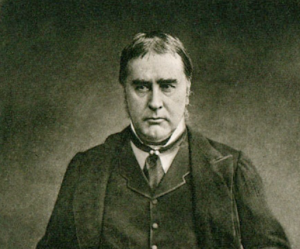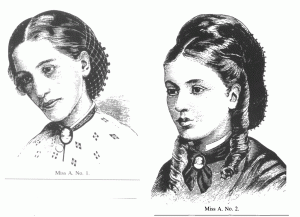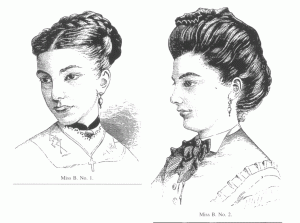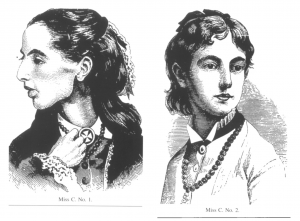 William Withey Gull. Anorexia Nervosa (Apepsia Hysterica, Anorexia Hysterica). Extrait de “Transactions of the Clinical Society of London”, 1868.
William Withey Gull. Anorexia Nervosa (Apepsia Hysterica, Anorexia Hysterica). Extrait de “Transactions of the Clinical Society of London”, 1868.
La première description de l’anorexie mentale fut donnée par le médecin anglais Richard Morton en 1700, sans avoir été nommée. C’est seulement en 1868 que le médecin William Withey Gull observa et dénomma le premier l’anorexie hystérique, et ce ne fut que le vendredi 24 octobre 1873, lors d’une réunion de la Clinical Society of London, qu’il réussit un coup de maître en livrant deux rapports décisifs. Le premier s’intitulait : « Anorexia Nervosa (Apepsia Hysterica, Anorexia Hysterica) ». Le second s’intitulait : « Sur un état crétinoïde important dans la vie adulte féminine ». Le manuscrit sur l’anorexie était considéré par les pairs de Gull comme important, mais de moindre importance. L’essai sur l’hypothyroïdie était généralement considéré comme le chef d’œuvre de Gull. Cent vingt-quatre ans plus tard, la situation s’est inversée : l’artcicle sur l’anorexie est devenu célèbre, tandis que l’autre manuscrit est presque oublié. L’article détaille les cas de deux jeunes femmes présentant une perte de poids sévère et inexpliquée, ainsi qu’une exploration plus générale de l’expérience de l’auteur quant à la maladie qu’il avait appelée « anorexie mentale ».
Sir William Withey Gull (1816-1890).Médecin britannique proche de la reineVictoria. Remarquable clinicien, fin observateur on lui doit, outre cette prière description clinique de l »anorexie, se travaux sur la glande thyroïde qui ont permis l’identification du myxœdème. Il devint populaire dans les années 1970, pour être l’un des suspects dans l’affaire de Jack l’Éventreur.
Anorexia Nervosa (Apepsia Hysterica, Anorexia Hysterica)
William Withey Gull, M.D., Bart.
Read October 24, 1873.
[p. 498, colonne 1]
In an address on medicine, delivered at Oxford in the autumn of 1868,(1) I referred to a peculiar form of disease occurring mostly in young women, and characterised by extreme emaciation, and often referred to latent tubercle, and mesenteric disease. I remarked that at present our diagnosis of this affection is negative, so far as determining any positive cause from which it springs; that it is mostly one of inference from our clinical knowledge of the liability of the pulmonary or abdominal organs to particular lesions, and by proving the absence of these lesions in the cases in question. The subjects of this affection are mostly of the female sex, and chiefly between the ages of 16 and 23. I have occasionally seen it in males at the same age.
To illustrate the disease I may give the details of two cases, as fair examples of the whole.
Miss A., let. 17, under the care of Mr. Kelson Wright, of the Clapham Road, was brought to me on Jan. 17, 1866. Her emaciation was very great. (Vide Woodcuts t Nos. 1 and 2.) It was stated that she had lost 33 lbs. in weight. She was then 5 st. 12 lbs. Height, 5 ft. 5 in. Amenorrhea for nearly a year. No cough. Respirations throughout chest everywhere normal. Heart-sounds normal. Resps. 12 ; pulse, 56. No vomiting nor diarrhea. Slight constipation. Complete anorexia for animal food, and almost complete anorexia for everything else. Abdomen shrunk and flat, col- lapsed. No abnormal pulsations of aorta. Tongue clean. Urine normal. Slight deposit of phosphates on boiling. The condition was one of simple starvation. There was but slight variation in her condition, though observed at intervals of three or four months. The pulse was noted on these several occasions as 56 and 60. Resps. 12 to 15. The urine was always normal, but varied in sp. gr., and was sometimes as low as 1005. The case was regarded as one of simple anorexia. [p. 498, colonne 2]
Various remedies were prescribed-the preparations of cinchona, the bichloride of mercury, syrup of the iodide of iron, syrup of the phosphate of iron, citrate of quinine and iron, &c.-but no perceptible effect followed their administration. The diet also was varied, but without any effect upon the appetite. Occasionally for a day or two the appetite was voracious, but this was very rare and exceptional. The patient complained of no pain, but was restless and active. This was in fact a striking expression of the nervous state, for it seemed hardly possible that a body so wasted could undergo the exercise which seemed agreeable. There was some peevishness of temper, and a feeling of jealousy. No account could be given of the exciting cause.
Miss A. remained under my observation from Jan. 1866 to March 1868, when she had much improved, and gained in weight from 82 to 128 lbs. The improvement from this time continued, and I saw no more of her medically. The Wood- cut, Miss A., No. 2, from photograph taken in 1870, shows her condition at that time. It will be noticeable that as she recovered she had a much younger look, corresponding in- deed to her age, 21; whilst the photographs, taken when she was 17, give her the appearance of being near 30. Her health has continued good, and I add a fourth photograph taken in 1872.
It will be observed that all the conditions in this case
were negative, and may be explained by the anorexia which led to starvation, and a depression of all the vital functions; viz., amenorrhea, slow pulse, slow breathing. In the stage of greatest emaciation one might have been pardoned for assuming that there was some organic lesion, but from the point of view indicated such an assumption would have been unnecessary.
This view is supported by the satisfactory course of the case to entire recovery, and by the continuance of good health.
Miss B., at. 18, was brought to me Oct. 8, 1868, as a case of latent tubercle. Her friends had been advised accordingly to take her for the coming winter to the South of Europe. [p. 499, colonne 1]
The extremely emaciated look (vide Woodcut, Miss B., No. l), much greater indeed than occurs for the most part in tubercular cases where patients are still going about, impressed me at once with the probability that I should find no visceral disease. Pulse 50, Resp. 16. Physical examination of the chest and abdomen discovered nothing abnormal. All the viscera were apparently healthy. Notwithstanding the great emaciation and apparent weakness, there was a peculiar restlessness, difficult, I was informed, to control. The mother added, “She is never tired.” Amenorrhea since Chrismas 1866. The clinical details of this case were in fact almost identical with the preceding one, even to the number of the pulse and respirations.
I find the following memoranda frequently entered in mynote-book: —pulse 56,resp.12 ; January1868,pulse54, resp. 12 ; March 1869, pulse 54, resp. 12 ; March 1870, pulse SO, resp. 12.’ But little change occurred in the case until 1872, when the respirations became 18 to 20, pulse 60.
After that date the recovery was progressive, and at length complete. (Vide Woodcut, Miss B., No. 2.)
The medical treatment probably need not be considered as contributing much to the recovery. It consisted, as in the former case, of various so-called tonics, and a nourishing diet.
Although the two cases I have given have ended in recovery, my experience supplies one instance at least of a [p. 499, colonne 2] fatal termination to this malady. When the emaciation is at the extremest, œdema may supervene in the lower extremities — the patient may become sleepless — the pulse become quick, and death be approached by symptoms of feeble febrile reaction. In one such case the post-mortem revealed no more than thrombosis of the femoral veins, which appeared to be coincident with the œdema of the lower limbs. Death apparently followed from the starvation alone. This is the clinical point to be borne in mind, and is, I believe, the proper guide to treatment. I have observed that in the ex- treme emaciation, when the pulse and respiration are slow, the temperature is slightly below the normal standard. This fact, together with the observations made by Chossat on the effect of starvation on animals, and their inability to digest food in the state of inanition, without the aid of external heat, has direct clinical bearings; it being often necessary to supply external heat as well as food to patients. The best means of applying heat is to place an india-rubber tube, having a diameter of 2 inches and a length of 3 or 4 feet, filled with hot water along the spine of the patient, as suggested by Dr. Newington, of Ticehurst. [p. 500, colonne 1]
Food should be administered at intervals varying inversely with the exhaustion and emaciation. The inclination of the patient must be in no way consulted. In the earlier and less severe stages, it is not unusual for the medical attendant to say, in reply to the anxious solicitude of the parents, ‘Let her do as she likes. Don’t force food.’ Formerly, I thought such advice admissible and proper, but larger experience has shown plainly the danger of allowing the starvation- process to go on.
As regards prognosis, none of these cases, however exhausted, are really hopeless whilst life exists; and, for the most part, the prognosis may be considered favourable. The restless activity referred to is also to be controlled, but this is often difficult.
It is sometimes quite shocking to see the extreme exhaustion and emaciation of these patients brought for advice ; yet, by warmth and steady supplies of food and stimulants, the strength may be gradually resuscitated, and recovery completed.
After these remarks were penned, Dr. Francis Webb directed my attention to the Paper of Dr. Lasègue (Professor of Clinical Medicine in the Faculty of Medicine of Paris, and Physician to La Pitié Hospital), which was published in the “Archives Générales de Médecine” April 1873, and [p. 500, colonne 2]translated into the pages of the “Med. Times,” Sept. 6 and 27, 1873.
It is plain that Dr. Lasègue and I have the same malady in mind, though the forms of our illustrations are different. Dr. Lasègue does not refer to my address at Oxford, and it is most likely he knew nothing of it. There is, therefore, the more value in his Paper, as our observations have been made independently. We have both selected the same expression to characterise the malady.
In the address at Oxford I used the term Apepsia hysterica, but before seeing Dr. Lasègue’s Paper, it had equally occurred to me that Anorexia would be more correct.
The want of appetite is, I believe, due to a morbid mental state. I have not observed in these cases any gastric disorder to which the want of appetite could be referred. I believe, therefore, that its origin is central and not peripheral. That mental states may destroy appetite is notorious, and it will be admitted that young women at the ages named [p. 501, colonne 1]
are specially obnoxious to mental perversity. We might call the state hysterical without committing ourselves to the etymological value of the word, or maintaining that the sub- jects of it have the common symptoms of hysteria. I prefer, however, the more general term “nervosa,” since the disease occurs in males as well as females, and is probably rather central than peripheral. The importance of discriminating such cases in practice is obvious; otherwise prognosis will be erroneous, and treatment misdirected.
In one of the cases I have named the patient had been sent abroad for one or two winters, under the idea that there was a tubercular tendency. I have remarked above that these wilful patients are often allowed to drift their own way in- to a state of extreme exhaustion, when it might have been prevented by placing them under different moral conditions.
The treatment required is obviously that which is fitted for persons of unsound mind. The patients should be fed at regular intervals, and surrounded by persons who would have moral control over them ; relations and friends being generally the worst attendants. [p. 501, colonne 2]
Addendum.
As a further illustration, I may add the following correspondence on one of these cases with Dr. Anderson, of Richmond.
Miss C., a t . 15 years 8 months, was sent to me in April 1873. The clinical history was that she had been ailing for a year, and had become extremely emaciated. (Woodcut, Miss C., No. 1.) The catamenia had never appeared. Pulse 64, resp. 16. Very sleepless for six months past. All the viscera healthy. Urine normal. Lower extremities œdematous. Mind weakened. Temper obstinate. Great restlessness. No family history of disease beyond the fact that the maternal grandmother had had peculiar nervous symptoms. I wrote the following letter to Dr. Anderson: —
DEAR DR. ANDERSON, — I saw Miss C. to-day. The case appears to be an extreme instance of what I have proposed to call “Apepsia hysterica,” or “Anorexia nervosa” (See “Address on Medicine at Oxford,” 1868.) I believe it to be essentially a failure of the powers of the gastric branches [p. 502, colonne 1] of the pneumogastric nerve. It differs from tuberculosis, though that state may subsequently arise, by the pulse, which I found to be 64, by the breathing, 16, the cleanness of the tongue, &c. In fact, the disease will be most correctly interpreted if it is remembered that no symptom more positive than emaciation is presented in and throughout its course.
‘I would advise warm clothing, and some form of nourishing food every two hours, as milk, cream, soup, eggs, fish, chicken. I must only urge the necessity of nourishment in some form, otherwise the venous obstruction, which has already begun to show itself by œdema of the legs, will go on to plugging of the vessels. With the nourishment I would conjoin a dessert-spoonful of brandy every two or three hours. Whilst the present state of weakness continues, fatigue must be limited, and if the exhaustion increases beyond its present degree the patient should for a time be kept in a warm bed. I do not at present prescribe medicines, because the nursing and the food are more important than any- thing else. Such cases not unfrequently come be- fore me; but as the morbid state is not yet generally recognised, I should be glad if you would second my wish of having a photograph taken of Miss C. in her present state, that we may compare it with some later one, if, as I hope, our plan of treatment is successful, as in my experience it generally is. I would, as I say, enclose a prescription, but I feel it most necessary to insist on food and stimulants, at least for a time.
Yours truly, [p. 502, colonne 2]
April 30, 1873.’
On May 24 I received the following note from Dr. Anderson : —
DEAR SIR WILLIAM, — I enclose photograph of Miss C… There is rather an improvement in one respect, viz. there is less aversion to food. Want of sleep and swelling of the feet are the two great troubles. You have given us all new hope, how- ever, and I trust I may one day send you a plump photograph, like what she was two years ago. With renewed thanks, I am, dear Sir William, yours very truly,’
On Oct. 23, 1873, I received a further report.
DEAR,SIR,WILLIAM, — Miss c.is now at Shanklin, but returns very soon. I hear she is much better. She had a bad slough on the leg near the ankle, from persisting in wearing a tight boot.
The great difficulty was to keep her quiet, and to make her eat and drink. Every step had to be fought. She was most loquacious and obstinate, anxious to overdo herself bodily and mentally. I will give you particulars when they return, but I am told she is-much improved. Rest, and food, and stimulants as prescribed, undoubtedly did her a great deal of good. She used to be a nice, plump, good-natured little girl. Believe me, &c.
The last report I received was on April 15, 1874.
DEAR SIR W., — I am sure you will be delighted to hear that Miss C., in whose case you were so kindly interested,.. . has now made a complete recovery, and is getting plump and rosy as of yore….. (Vide Woodcut, Miss C., No. 2.)
Note
(1) Lancet, August 1868.
The woodcuts illustrating this Paper are fac-similes of the original photographs exhibited at the time the Paper was read.
Adapted from Transactions uf the Clinicul Societ?, of London. 7:22-28, 1874. Reprinted with permission.




LAISSER UN COMMENTAIRE